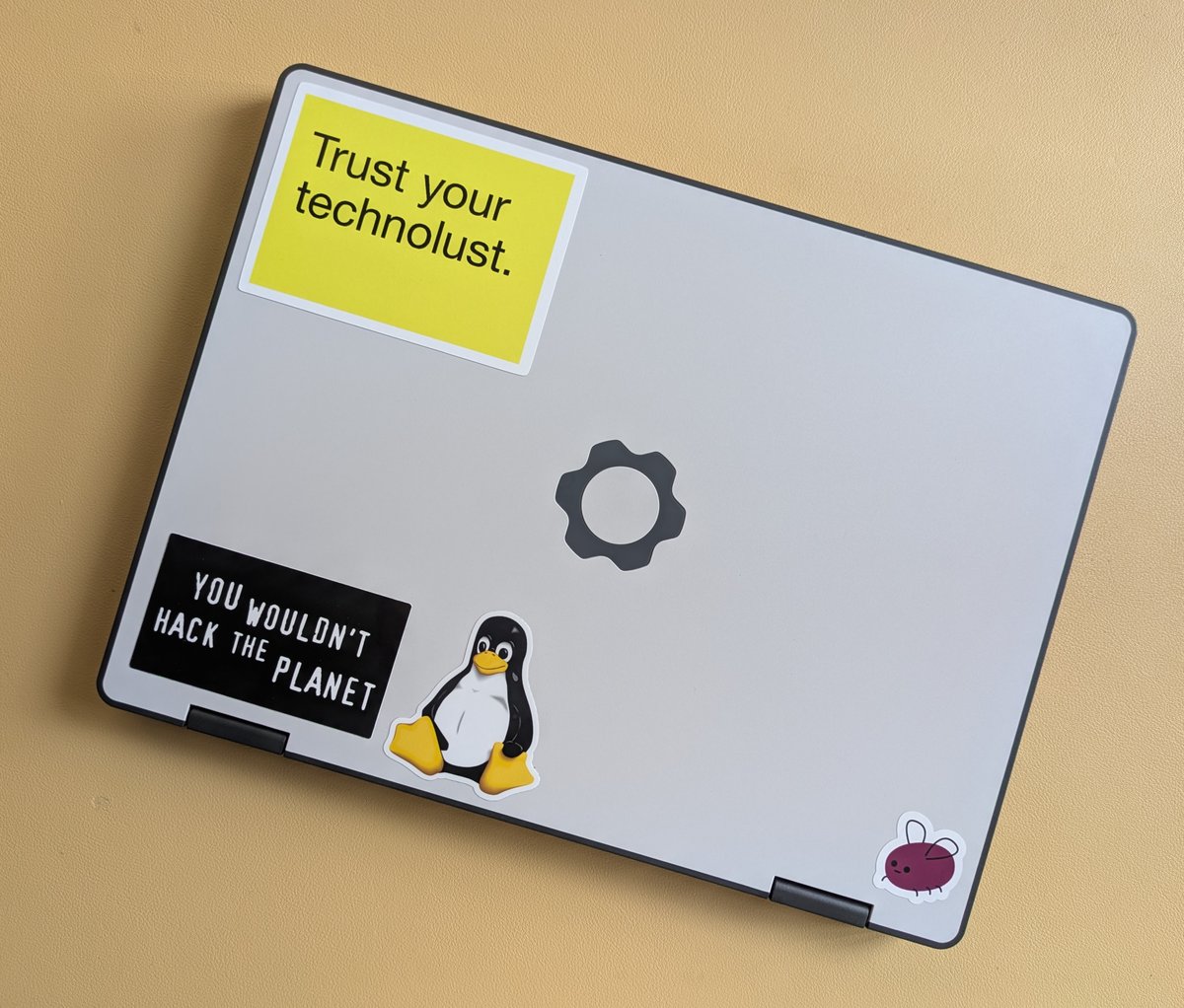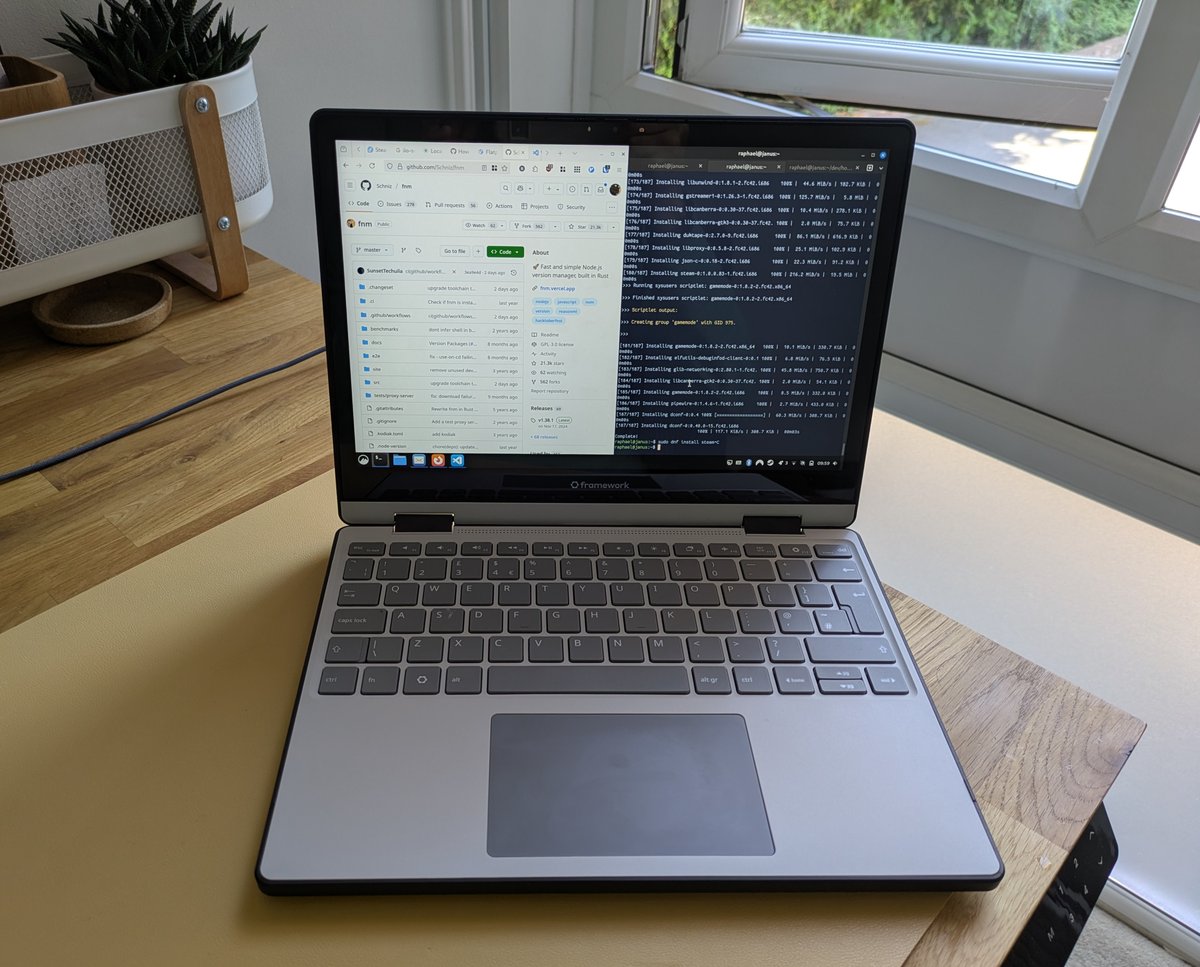The Framework 12 is the Thinkpad X220 we deserve in 2025
 Of course I covered it in stickers immediately. 'Trust Your Technolust' is available from my Redbubble store!
Of course I covered it in stickers immediately. 'Trust Your Technolust' is available from my Redbubble store!
Before my Framework 12 arrived in the post today, my favourite ever laptop was a Thinkpad X220 I bought almost 10 years ago, when it was already some 5 years old. I did so many good things on that thing. I wrote a PhD thesis. I coded a utopian social network. I replaced the old barrel charging port with a USB-C port designed by an awesome DIY hacker. I performed open heart surgey on its BIOS chip to replace the boot firmware with Coreboot. I installed at least five Linux distros on it. I took it to hacker camps and festivals. And of course, I covered it with stickers. It was a computer shaped like a friend, and I would trade a hundred beautiful sleek MacBooks for one of those.
The things I loved about the X220 were what everyone loved about it: it was small, built like a cross between a tank and a bento box, had a really excellent keyboard, a great selection of ports (alas, no HDMI), was easy to customize and modify, and parts for repair were cheap and plentiful. But it had its drawbacks too. By 2025, its processor was getting long in the tooth. I could still code on it, but video games were out of the question. Its screen wasn't particularly good, even after I replaced the stock panel with an IPS panel. Its mousepad was beyond terrible - yes, the trackpoint was cool, but it was also the only reasonable way to move a cursor around the screen. It had an awful webcam and I never got around to working out which Bluetooth cards it was compatible with. Its battery life was laughable, even with the extended battery pack with integrated carry handle which made it feel a bit like the world's most Matrix-y handbag. Worst of all, my particular device had a frustatingly hard-to-diagnose bug where the whole thing would just freeze up, with no warning and no pattern, and require a restart to work again. In short, I loved it, but it was time to move on.
When I saw the launch announcement for the Framework 12, I was beyond excited. I didn't own any Framework devices, but I've been following the company for a few years, and this new device, in its product design and its marketing, felt like it could be another computer shaped like a friend. I bought one the hour it launched, ready every one of the steady drip of reviews, and waited very patiently for it to arrive. I've now had it for twelve hours and am writing this blog post on it.
The Framework 12 incorporates the best qualities of the hackable, tactile, and versatile Thinkpad X220 while addressing and solving its drawbacks. It is destined to become my new favourite laptop.
I am impressed with Framework as a company not only because they stick by their customers, are transparent and honest in an era of corporate obfuscation, and prove by their actions their belief that the best way to do business is to let people repair and hack their devices, not lock them in. In the consumer tech space, that's a corporate philosophy every bit as radical as Patagonia's.
I'm actually more impressed by the fact that Framework do all this while their products are consistently misrepresented in the press. Through determination and tenacity - and presumably some heavy investment - Framework are now enough of a contender that their new products are routinely reviewed in major consumer magazines like Wired and The Verge. But the yardstick by which they are reviewed is consistently that of other consumer laptops - which tend to be underpowered, not designed for Linux, barely repairable, and rarely innovative. They also tend to be cheaper. I have for this reason read a number of reviews of the Framework 12 which compare it unfavourably to the MacBook Air and Microsoft Surface, simultaneously lauding its repairability while criticising its price, comparing it to products from companies which make their profits on charging huge sums for repairs or convincing customers to replace perfectly servicable hardware with the next big thing (see, for instance, the incredible marketing boondoggle of the 'AI-ready chip'). Patagonia seems to have sailed through this space - reviews of their products always acknowledge the cost of their products and the production choices they make as a necessary factor of their commitment to helping people and the planet. Framework deserves similar treatment. Their laptops cost what they cost because that's what it takes to create a product built to last and designed for years of future innovation, not just for the current big thing.
So here are my thoughts on the Framework 12, not from the point of view of a consumer magazine, but from that of a coder, hacker, and tinkerer - from the point of someone who thinks hardware design peaked the moment the devices we could replace every part of also got wifi.
The Framework 12 comes in a range of joyful colours, although I did go with light gray for maximum sticker potential. Just as the Thinkpad is synonymous with a slightly soft plastic finish, the finish of the Framework 12 is slighty, delightfully rough and feels tough and sturdy. With its contrasting bumpers and slightly squared off design, and its lovely 12-inch form factor, it's as much of a friendly bento box as the Thinkpad X220, but a little lighter and sleeker. This is not a laptop that will slide out of your fingers - it's a laptop that will stay with you through any adventure.
Unboxing the laptop was an absolute joy, and assembling it was a breeze. I bought a stick of RAM and an SSD online - doing so was significantly cheaper than buying these same third-party items via Framework, something I see The Verge, with its obsession with price, is weirdly quiet on - and both worked without a hitch. I am genuinely astounded by the number of clever, thoughtful technical decisions I've seen inside this one laptop. A keyboard and mousepad top shell that stays attached via magnets and interfaces via pogo pins. Captive screws. Magnetized RAM covers. Modular plug-and-play ports of all varieties - USB-C, USB-A, HDMI, Ethernet, and more - which fit any way you desire into the four port slots on the sides. The freedom of deciding where my USB-C ports will go, and the knowledge that if I'm ever faced with a short HDMI cable I can just switch my HDMI port to the other side of the laptop - these are rare joys that will stay with me for a long time.
I love that the webcam and microphone can both be disabled with a physical switch. I love the touchscreen, which is responsive, really bright, and crisp - very much an improvement on the Thinkpad's. I love the mousepad, which is remarkably good - smooth, comfortable, and precise. I love the keyboard, which has a good deep key travel, full-size keys, and is satisfying and comfortable to hammer away on. Those are the things that make or break devices for me - their tactile and physical instruments. I hated my 'butterfly keyboard and touchbar' MacBook Pro. I loved my Thinkpad. I will love my Framework 12.
I chose to install the Cinnamon Spin of Fedora, a process which also went so smoothly as to be barely worth mentioning. So, an hour after first booting the laptop up, I had a device with a screen which automatically rotated when I put it in tablet mode, with a dismissable onscreen keyboard, connected to my Bluetooth headphones and my local file storage, and I was watching an episode of Star Trek on it - with it propped up in tent mode next to the food processor while I was making dinner. One hour to Star Trek - that's surely the best metric of a convertible, open, flexible, joyful device like this.

I do already have a list of things which could be improved - some in software, some in hardware. When the laptop is in tent mode, I can't use the media keys on the back, even to adjust the volume. This may be controllable by a BIOS setting. The keyboard isn't backlit, which isn't a concern for me because I touch-type. (Ironically, I'm writing in the dark in bed and I misspelled the word 'touch' three times in that sentence). The Cinnamon DE does not present the greatest touchscreen experience - select boxes don't stay open, the global menu isn't properly scrollable, and the onscreen keyboard is hit and miss - but these can all be fixed by contributing to open source code or switching to a different DE, probably Gnome or KDE. The speakers are quite weak - certainly I was having trouble watching Star Trek in a loud kitchen without headphones. But they were fine for background music while I was writing. The screen bezels are relatively wide for a laptop in 2025, but I'm sure that an improved display will be released in a few years. These are all such minor issues and I already love this little thing so much. I've called it Janus, partly because it flips in two directions but also because it looks forwards and backwards - to the repairable, open hardware of the past, and the innovations we haven't even imagined in the future. It's a laptop shaped like a friend, and I can't wait for the adventures we're going to have in the many years we're going to spend together.
